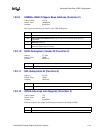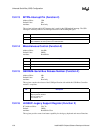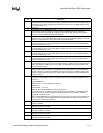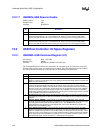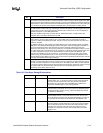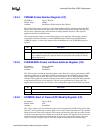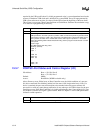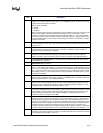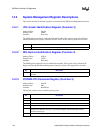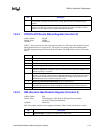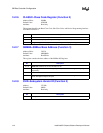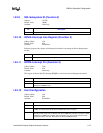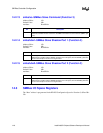
Intel® 460GX Chipset Software Developer’s Manual 13-13
Universal Serial Bus (USB) Configuration
12 Suspend–R/W. 1=Port in suspend state. 0=Port not in suspend state. This bit should not be
written to a 1 if global suspend is active (bit 3=1 in the USBCMD register). Bit 2 and bit 12 of this
register define the hub states as follows:
Bits [12,2] Hub Port State
x0 Disable
01 Enable
11 Suspend
When in suspend state, downstream propagation of data is blocked on this port, except for single-
ended 0 resets (global reset and port reset). The blocking occurs at the end of the current
transaction, if a transaction was in progress when this bit was written to 1. In the suspend state,
the port is sensitive to resume detection. Note that the bit status does not change until the port is
suspended and that there may be a delay in suspending a port if there is a transaction currently in
progress on the USB.
11 Over-current Indicator Change–R/WC. 1=A change from 1 to 0 has been detected on the Over-
current (OC[X]#) pin for this port. 0=No change has been detected. Software sets this bit to 0 by
writing a 1 to it.
10 Over-current Indicator–RO. 1=Overcurrent pin (OC[X]#) for this port is at logic 0 indicating over-
current condition. 0=Overcurrent pin for this port is at logic 1 indicating a normal condition. If
asserted, the corresponding port is disabled.
9 Port Reset–R/W. 1=Port is in Reset. 0=Port is not in Reset. When in the Reset State, the port is
disabled and sends the USB Reset signaling. Note that host software must ensure that the
RESET signaling is active for the proper amount of time as specified in the USB Specification.
8 Low Speed Device Attached–RO. 1=Low speed device is attached to this port. 0=Full speed
device. Writes have no effect.
7 Reserved–RO. Always read as 1.
6 Resume Detect–R/W. 1= Resume detected/driven on port. 0=No resume (K-state) detected/
driven on port. Software sets this bit to a 1 to drive resume signaling. The Host Controller sets this
bit to a 1 if a J-to-K transition is detected while the port is in the Suspend state. Note that when this
bit is 1, a K-state is driven on the port as long as this bit remains 1 and the port is still in suspend
state. Writing a 0 (from 1) causes the port to send a low speed EOP. This bit will remain a 1 until
the EOP has completed.
5:4 Line Status–RO. These bits reflect the D+ (bit 4) and D- (bit 5) signals lines’ logical levels. These
bits are used for fault detect and recovery as well as for USB diagnostics. This field is updated at
EOF2 time (See Chapter 11 of the USB Specification).
3 Port Enable/Disable Change–R/WC. 1=Port enabled/disabled status has changed. 0=No
change. For the root hub, this bit gets set only when a port is disabled due to disconnect on the
that port or due to the appropriate conditions existing at the EOF2 point (See Chapter 11 of the
USB Specification). Software clears this bit by writing a 1 to it.
2 Port Enabled/Disabled–R/W. 1=Enable. 0=Disable. Ports can be enabled by host software only.
Ports can be disabled by either a fault condition (disconnect event, overcurrent condition, or other
fault condition) or by host software. Note that the bit status does not change until the port state
actually changes and that there may be a delay in disabling or enabling a port if there is a
transaction currently in progress on the USB.
1 Connect Status Change–R/WC. 1=Change in Current Connect Status. 0=No change.
Indicates a change has occurred in the port’s Current Connect Status (see bit 0). The hub device
sets this bit for any changes to the port device connect status, even if system software has not
cleared a connect status change. If, for example, the insertion status changes twice before system
software has cleared the changed condition, hub hardware will be “setting” an already-set bit (i.e.
the bit will remain set). However, the hub transfers the change bit only once when the Host
Controller requests a data transfer to the Status Change endpoint. System software is responsible
for determining state change history in such a case. Software sets this bit to 0 by writing a 1 to it.
0 Current Connect Status–RO. 1=Device is present on port. 0=No device is present. This value
reflects the current state of the port, and may not correspond directly to the event that caused the
Connect Status Change bit (Bit 1) to be set.
Bit Description



